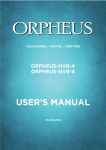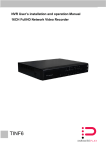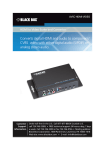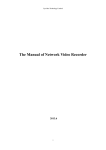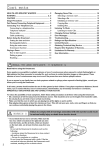Download Network Video Recorder User Manual 20140710
Transcript
Network Video Recorder User Manual 2014.7 NVR User Manual Content 1 Precautions..................................................................................................................................... 4 2 Declaration ..................................................................................................................................... 4 3 Product Introduction ......................................................................................................................4 3.1 Product Overview................................................................................................................4 3.2 Feature ................................................................................................................................4 4 Installation...................................................................................................................................... 5 4.1 Unpacking Inspection .......................................................................................................... 5 4.2 Installation Preparation....................................................................................................... 5 4.3 Installation of the burner .................................................................................................... 5 4.4 The Front Panel ...................................................................................................................7 4.5The Rear Panel .....................................................................................................................9 4.6 The Alarm Cable ................................................................................................................11 4.7 The Connection of POE ..................................................................................................... 12 5 Basic Operations Guide ................................................................................................................12 5.1Power On and Off............................................................................................................... 12 5.1.1 Power On ................................................................................................................12 5.1.2Power Off ................................................................................................................12 5.2Preview and Login in .......................................................................................................... 13 5.2.1 Preview ...................................................................................................................13 5.2.2Login In ....................................................................................................................13 5.3 Mode Switching ................................................................................................................13 5.4IP Camera ...........................................................................................................................14 5.4.1Add IP Camera ......................................................................................................... 14 5.4.2Status Display .......................................................................................................... 19 5.5 PTZ Control ........................................................................................................................19 5.5.1PTZ configuration .................................................................................................... 20 5.5.2Quick location ......................................................................................................... 20 5.6 Search ................................................................................................................................20 5.7 Record ...............................................................................................................................20 5.8Alarm .................................................................................................................................. 23 5.8.1 Alarm Output ......................................................................................................... 23 5.8.2Alarm Configuration ................................................................................................23 5.8.3Alarm Status ............................................................................................................ 24 5.9 Color Setting ......................................................................................................................25 5.10 The Input Method ........................................................................................................... 25 6 Parameter Settings .......................................................................................................................26 6.1 Introduction Of Main Menu ..............................................................................................26 6.2 Video Settings ...................................................................................................................26 6.2.1Basic ........................................................................................................................26 6.2.2Encoding settings .................................................................................................... 27 6.2.3Snapshot..................................................................................................................27 6.2.4Net Channel............................................................................................................. 28 NVR User Manual 6.3 Record ...............................................................................................................................28 6.4 Network.............................................................................................................................29 6.5 PTZ Configuration .............................................................................................................. 31 6.6Alarm .................................................................................................................................. 31 6.6.1 Video Detection...................................................................................................... 31 6.6.2Alarm input ............................................................................................................. 32 6.6.3Alarm out ................................................................................................................32 6.7System ................................................................................................................................33 6.7.1 Base ........................................................................................................................33 6.7.2Display .....................................................................................................................33 6.7.3Storage ....................................................................................................................34 6.7.4Abnormity ............................................................................................................... 35 6.7.5Status.......................................................................................................................35 6.7.6Maintain ..................................................................................................................35 6.7.7Account ...................................................................................................................36 6.7.8RS232.......................................................................................................................37 7 Web and Client .............................................................................................................................37 7.1 Web Operation ..................................................................................................................37 7.1.1 Network Connection ..............................................................................................37 7.1.2 The control installation and the user login logout .................................................38 7.1.3 The Interface of Web Operations ........................................................................... 39 7.1.4 The Real-time Monitoring ......................................................................................39 7.1.5 PTZ Control ............................................................................................................. 41 7.1.6 Configuration.......................................................................................................... 42 7.1.7 Search Record......................................................................................................... 42 7.1.8 Alarm Configuration ...............................................................................................43 7.1.9 About ......................................................................................................................44 7.2 The Client Operations........................................................................................................ 44 8Appendix ....................................................................................................................................... 44 8.1Expansion function............................................................................................................. 44 8.1.1 DDNS Function ....................................................................................................... 44 8.1.2 PTZ Control .....................................................................................................................47 8.2HDD Capacity Calculation................................................................................................... 48 8.2.1 Reference of HDD Capacity Calculation ................................................................. 48 8.2.2Hard disk problem ................................................................................................... 48 8.3 Common Faults .................................................................................................................50 NVR User Manual 1 Precautions The following content is about use of the product, the prevention of danger as well as preventing property from the loss. Please be sure to comply. 1、Please placed NVRs within the permissible range of temperature and humidity. 2、Do not install the NVRs in a damp, dust or soot place. 3、Place the product horizontally and pay attention to preventing it from falling. 4、Installed in a well-ventilated place and do not block the vent. 5、Do not place containers filled with on the device. 6、Do not place other equipments above the product. 7、Do not disassemble this product. 8、Please select the hard disk recommended by manufacturers and suitable for the requirements of the NVR. 2 Declaration Please prevail in kind. The manual is for reference only. This manual may contain inaccurate data or printing error. The products described in this manual may be updated at any time. Screenshots of the manual is not in a machine and only for display. If in doubt, obtaining a copy of the latest procedure or the additional document, please contact with the company's after-sales department. 3 Product Introduction 3.1 Product Overview This Network Video Recorder (NVR) is an excellent digital surveillance product which uses H.264 video compression, hard disk recording, TCP/IP transmission, and a Linux-based Operating System. It also uses advanced technologies that produce a more stable, reliable and higher quality video image. This NVR supports synchronized video and audio recording, playback, and monitoring. This series also supports network-based system control, as well as excellent network streaming capabilities. 3.2 Feature Real-time monitoring Have a composite video signal interface and support CVBS, VGA or HDMI output simultaneously. Compression function Use H.264 video compression standard and G.711 audio compression standard and have high NVR User Manual definition, low code rate of the video coding and the storage. Recording function Support timing, linkage alarm, motion detection, SATA hard and local hard disk, NVR data backup and network backup. Video playback function Achieve searching videos by a variety of conditions, playback in local and network. Support multiple videos playback, fast playing, slow playing and frame-by-frame playback. Video playback can display the exact time of the incident. Provide timeline retrieving page for quick searching. Camera control and alarm Be controlled by the remote camera and equip many alarm input interfaces. Be connected to various types of alarm devices. Dynamic detection, video loss, video block, multiple alarm output and scene lighting control can be realized. Communication Interface Equip USB 2.0 high-speed interface or ESATA interface and allow many backup devices. Equip standard Ethernet interface. Plug and play in a variety of network conditions, Network functions Support TCP / IP, UDP, RTP / RTSP, DHCP, PPPOE, DDNS, NTP etc. Support real-time network monitoring, video playback, control and management functions; built-in WEB Server, you can directly access through a browser. Mode of operation You can operate by the front panel or the mouse. Equip a simple, intuitive graphical interface. 4 Installation 4.1 Unpacking Inspection When you receive a product, check it according to the packing list inside the box. 4.2 Installation Preparation Tools & Preparation You will need a Philips-head screwdriver and a hard disk drive to install inside the NVR housing. NVR User Manual Hard Disk Specifications: 3.5-inch SATA hard disk drive (maximum capacity is 2TB). Installation Steps Make sure to take precautions against static electric discharge when installing the hard disk. Static discharge could damage the drive and the internal components of the NVR. To reduce this risk, it is best to work on an anti-static mat and use a grounding wrist strap. 1. Use a Philips-head screwdriver to remove the NVR’s outer metal housing by removing the two screws on each side of the housing and the one at the upper back edge. Set the screws aside to be used for reassembly. 2. The hard disk will have mounting holes on the underside of the drive and these should line up with the mounting holes in the bottom of the NVR. Orient the drive so that the power and data cable connectors are facing the front of the NVR and align the mounting holes on the hard disk with the mounting holes in the bottom of the NVR. Use the supplied screws to fasten the hard disk to the NVR’s metal frame by inserting the screws from the outside of the NVR through the housing and then screw them into the hard disk’s mounting holes. To avoid undesirable results it is important that the hard disk be securely mounted to the NVR. 3. Connect the power and data cables from the NVR circuit board to the hard disk. The connectors are of different sizes and are keyed for easy and correct placement. 4. Replace the NVR outer housing and secure it with the housing screws. Note: The capacity of the hard disk determines how much video can be recorded to the hard in addition to whatever NVR parameters (recording or encoding setup) have been set to make the recording. Refer to section 9.3 in Chapter 9 of this manual for more information. 4.3 System Installation Preparation Before you integrate the NVR into a complete surveillance system, you will need to assemble all the necessary components and connecting cables. These include IP cameras with their power adapter(s) and network cables (RJ45 connector), a router or switcher to connector IP camera and NVR, a video display monitor to display the camera video feed, and connecting cables for all devices. Connecting the NVR to a System To connect the NVR to the other components in a surveillance system you will need to do the following: Place the NVR on a flat stable surface and connect a network cable from the RJ45 network interface to a router or switcher. Connect the IP cameras to the same router or LAN with network cables. Connect the VGA (or HDMI) video output port to the system display monitor. Connect the supplied USB mouse to one of the USB 2.0 ports on the rear panel of the NVR. Plug in the AC power adapter into the power jack on the rear panel of the NVR. NVR User Manual 4.4 The Front Panel Index Name 1 LCD Function 1、 IP address of the device,the clock,the external alarm channel,error status code of the machine, remote address, internal temperature of the chassis is displayed. 2、Network Connection status. 3、HDD status and numbers. “E” and flash label refer HDD error. 4、Cycling display the recording status and motion detection (distinguish by “REC” and“MOVE”). 2 IR 3 Esc Receive the remote control signal. Back to previous menu, operation cancel; Back to live view when playing back records. Up/Down: Move up or down.Change the settings and increase or decrease 4 Direction the digital. Left/Right: Control the playback control bar of the records. Confirm the operations. 5 Enter Jump to the default button. Enter the menu. The button displays PTZ control and image color when in a single-screen monitoring. Simultaneously press the Fn key and the direction key to complete the 6 Fn settings with the dynamic monitoring area. Press the Fn key to empty all contents of the edit box. Press the key to switch between the digital casein English, Chinese input. Special with the function of each menu page prompts. 7 USB 8 ON/OFF To connect the mouse and HDD. Power on/off. (D70XX Series) NVR User Manual (D60xx series) (D61xx series) Index Name Function 1 Sign NVR Logo 2 Indicators Power On, HDD/Network /Alarm/Recording Active Directional controls: Up/Down can jump up or down. Activates the digital input box to 3 Directional keys increase or decrease a number. Left/Right: Switches screens Switches to default button Enter: Operation confirmation Menu configuration. 4 Function Keys Function keys, and the corresponding number key to switch or exit the function keys 5 IR/Ext.IR Receives signals from the remote control 6 USB USB 2.0 Ports for mouse & external device 7 Power key Long press to power on/off NVR system. NVR User Manual 4.5The Rear Panel 4/8CH NVR with POE Rear Panel Interfaces Index Name Description 1 Microphone input 2-way talk 2 Audio output The input interface of the audio signal 3 Video output The input interface of the video signal 4 The HDMI interface The output interface of the HDMIvideo signal 5 The VGA interface The output interface of the VGA video signal 6 Alarm/RS485 Ports Alarm input/ output and RS-485 interface 7 The network/USB interface The network interface of RJ-45 and USB interface 8 PoE ports 9 The power input Network Interfaces with PoE function The power input interface(12V) 10 The power input The power input interface(48V) 11 The power switch The power switch D70xx series 4/8CH NVR with POE Rear Panel Interfaces NVR User Manual D60/D61 xx series 4/8CH NVR with POE Rear Panel Interfaces 6 3 1 4CH NVR Rear Panel Interfaces (Mini case) 4/8CH NVR Rear Panel Interfaces 16CH NVR Rear Panel Interfaces 2 4 NVR User Manual 32CH NVR (1U case) Rear Panel Interfaces 32CH NVR (2U case) Rear Panel Interfaces Index Name Description 1 The video/audio output The input interface of the audio signal 2 The network interface The network interface of RJ-45 3 The VGA interface The 4 The power input The power input interface 5 the terminals The interface of the alarm input,the alarm output and RS-485 6 The HDMI interface The 7 The power switch The power switch output interface of the VGA video signal output interface of the HDMIvideo signal 4.6 The Alarm Cable Examples of alarm input connections The alarm input is the switch quantity input. If the alarm input signal is not switch quantity signal but voltage signal, refer to the following connection. Examples of alarm output connections When the alarm output connect with DC and AC load, please refer to the connection. NVR User Manual 4.7 The Connection of POE Step 1: Supply the NVR with the 12V DC power. Step 2: Connect the POE module with 48V directly power. Note: 48V voltage is not safe, please pay attention to the use of electricity. Step 3: The side of the network cable is connected to the POE network interface and the other side is connected to the network camera. The distance of POE power i s not more than 100 m theoretically. 5 Basic Operations Guide 5.1 Power On and Off 5.1.1 Power On Correctly install and power on the NVR. When the power indicator lit up, the NVR will automatically start.NVR will automatically detect hardware state of the device during the starting. The booting process will continue for about 30 seconds. After boot, the equipment sounds and then enters the state of multi-screen real-time video surveillance. 5.1.2 Power Off Press the power key for three seconds to achieve shutdown.Enter the NVR’s [main menu]shutdown] and select [shutdown]. NVR User Manual 5.2 Preview and Login in 5.2.1 Preview After the device is turned on, you will enter the real-time monitoring interface. Right click and the following interface will pop up. 5.2.2 Login In Click the image above with [main menu], and then input the user name(default:admin)and the password of the NVR(default:123456)to complete the login. 5.3 Mode Switching The device can work in hybrid mode or NVR mode. Hybrid-mode can be connected with both analog cameras and network cameras while NVR mode can only support IP cameras. Enter [configuration]- [system]-[channel mode] to select the mode. Restart to complete the setting. NVR User Manual 5.4 IP Camera 5.4.1 Add IP Camera NVR add IPC have two patterns, one way is a key to add(UPNP), the other way is manual bulk adding mode. When use UPNP function to add IPC,The equipment has been added menu “Chn IP/DoMain” and show the IPC MAC address. When use manual bulk adding mode, the RJ45 port of NVR should connect the router or DHCP server,and make sure the router or DHCP server can distribute IP address to NVR and IPC. (1) A key to add (UPNP) Step 1:After the device is turned on, choose ’’open upnp’’, Enter the user name:”admin” and password: “123456”. Click OK. Step 2:System prompt” UPNP is turned on , it will automatically turn off after 10 minutes .” Click OK ,system will automatically add IPC to all NVR channel. Right click USB mouse, NVR User Manual choose NET Channel Management, then you can find the added IPC information on ”the equipment has been added “. Remark: Status bar show green icon that means the IPC have been connected successfully. (2) Manual bulk adding mode Step 1: Please check NVR menu” DHCP” option is checked, and prompts obtain IP Automatic Configuration. Step2 : Go back to “LIVE“ window , right click USB mouse and choose “NET Channel Management”. NVR User Manual Step 3: Choose “ONVIF” in the ”Filter” option. NVR User Manual Step 4:Click “Search” to search the connected IPC. Step 5:Check the need to add IPC, and click “BatchAdd” to add. NVR User Manual Step 6:After to finish the add, the menu “the equipment has been added” will show the added IPC list and information. Remark: Status bar show green icon that means the IPC have been connected successfully. NVR User Manual 5.4.2 Status Display Right click in the real-time monitoring screen and select [net channel] to view the status of the network channels. 5.5 PTZ Control When connect with a network ball, right click the corresponding network channel and select [PTZ] to enter into thePTZ interface.If access to a simulated ball machine, enter [Main Menu] - [PTZ] to modify the PTZ protocol, the baud rate and address bits. Then right click in the corresponding channel and select [PTZ].The PTZ control interface is shown as the following interface. Click to enter the PTZ configuration page. Refer to 8.2 about more details. NVR User Manual 5.5.1 PTZ configuration The direction of PTZ, steps, zoom, focusing, iris, preset points, cruising between points, patrols, sweeping the boundary, calling an auxiliary switch, light switch, horizontal rotation are controlled with the usage of the arrow keys. The [Step] is mainly used to control directions.The figure can be set from 1 to 8. Directly click or to adjust zooming, sharpness and brightness adjustment. PTZ supports eight directions. 5.5.2 Quick location Quick location: <SIT>is in the middle of the direction arrows.Make sure that the protocol supports this function. PTZ will turn to the clicked point and move it to the centre of screen.It also supports zooming.Drag the mouse in the quick location page.The dragged box supports 4 to 16 times zooming. Hold the mouse and drag it up to complete zoom of the box.Drag it down to narrow the box. Refer to 7.1.5 about more details. 5.6 Search In real-time monitoring screen, right click and select【search】to enter the searching interface. NVR User Manual Index Type Description 1 Calendar Click a specific date to call up the recording. The list is upgraded automatically. 2 Time Select recording search start and end time. 3 Play Playback control: stop/play, pause, fast, slow, previous/next frame when in pause mode. 4 Recording mode Choose searched recording mode, including NORMAL, ALARM & MOTION. 5 Channel Choose searched channel 6 Play Choose to play the previous or next file; choose to play the previous or next channel. 7 List Choose the start time, channel, click “search”, and a list will display the results. 8 Backup Click “ ”to choose a backup file in the file list box, click the Backup button; to cancel a backup file, click “√” from the backup menu “√”. 9 Recording List The search list displays up to 128 video recordings. Choose a file and press enter or double-click with the mouse to view a recording.File types: R—normal recording, A—alarm recording; M—motion detection recording. NVR User Manual Playback Control: Key Description Video playback : Fast-Forward button During playback, pressing this key, allows you to Fast-Forward with a number of speeds to choose from. The Fast-Forward button can also be used as a reverse of the Slow Motion key. Video playback : Slow Motion Key Remark During playback, pressing this key Actual play rate is based on provides a variety of slower playback the version being used. speeds to choose from. The Slow Motion key can also be used as a reverse of Fast-Forward. Play/pause►/ Play/pause can also switch to normal speed from slow motion playback. Backward: Backward Key Moves the video playback a single frame backward. Manual single frame advance Advance video by a single frame forward or back by clicking either │ or │ when video is paused. To go backwards, single click again. To stop backward play during normal playback, press Rewind or single-frame advance. Press the play button ►/ to resume normal playback. Note: 1. The NVR playback control bar shows file playback speed, channel, time, playback progress and other information. 2. The playback speed and rewind functions can differ between NVR versions. Please check the NVR version you have in order to ensure successful operation. 5.7 Record In real-time monitoring screen, right click and select【record】to enter the interface. 【Manual】It has the highest priority and corresponding channels will record for whole days after chosen. 【Schedule】Record according to recoding configuration. 【Stop】Stop recording. NVR User Manual 5.8 Alarm 5.8.1 Alarm Output This menu manages alarm output parameters and displays the current state of alarm. 【Channels】The number of channels that are in alarm status. 【Schedule】Alarm output is in control of alarm configuration. 【Manual】Alarm output is on and the status is active. 【 Stop】 Alarm output is off and the status is inactive. 【Status】The current status of alarm output. Notice: Some models don’t have thelocal alarm, please refer to the products descriptions. 5.8.2 Alarm Configuration Detect Enter [main menu]-[detect]. [Channel]Select the channel. [Alarm type]Dynamic monitoring, video loss and video blind can be selected. :Open the enable switch. [Sensitivity]Set sensitivity of the network channels. [Set area]It should be set in the IPC. [Process]Click the button to set the alarming time, linkage and the handling method. NVR User Manual [Linkage Set]When produce an alarm, you can activate the linkage of records, PTZ, touring and capturing. Alarm Input Enter [main menu]-[alarm]-[alarm input]. 【Alarm input channel no.】Select a channel. 【Enable】Select the enable switch. 【Type】It can be normal open or close. 【Process】and 【Linkage】Refer to [Detect]. 5.8.3 Alarm Status If you select [Show Message] in linkage settings, the following message will pop up when the alarm occurs. NVR User Manual 5.9 Color Setting Adjust the specified screen (single screen) image color hue, brightness, contrast, saturation, gain and white-level parameters set two time periods according to the local environment difference between day and night for each adjustment period set, the device will automatically switch to the best video quality. 【Period】Two periods can be set according to ambient light during the day and night, device will automatically switch configuration time. Need to select the Enable box. 【Hue】Adjust according to color cast of image. 【Brightness】Visual image brightness, according to the environment, reduces or increases the brightness of the image brightness to make the image relatively clear. 【Contrast】Adjust image of black and white in proportion, the greater ratio, the brighter image. 【Saturation】Image color purity, the greater value, the more colorful images. 【Gain】Enlarge the image signal to improve signal quality. 【White Level】Change the white level reference value, to improve the brightness of the image display. Note: Only analog channels support the function. 5.10 The Input Method In the input box, you can select figures, symbols, English capitalization and the input of Chinese.Click the mouse to complete the input.”← “represents the backspace and “_ “represents a space. The input interface of Englishfigures The input interface of Chinese NVR User Manual 6 Parameter Settings 6.1 Introduction Of Main Menu The main menu is shown in the following interface. 【Search】Search records by types, channels, time and playback records. 【Video】Set basic, encoding, snaps and net channels. 【Record】Set basic and record plan. 【Network】Set base,advanced and apply network. 【PTZ】Set parameters of PTZ. 【Alarm】Set alarm information. 【System】Set basic,display,storage,abnormity,status,maintain,account and RS232. 【shutdown】It includes menu logout,shutdown and restart of the system. 6.2 Video Settings This menu contains the basic video settings, video encoding settings, the capture channel access and network settings. 6.2.1 Basic 【Channel】Select the desired channel. 【 Channel name 】 Select the channel name. 【Channel display】Set the position of the channel title. 【Time display】The position of the time title in the screen. 【 Time Synchronization 】 Time synchronization of network channels and the device. 【Video cover】Set protected area of previewing and recording. NVR User Manual 6.2.2 Encoding settings 【Channel】Select the desired channel. 【Compression】H.264 【Resolution】The resolution of main stream can be D1 orCIF. Different channels correspond to different resolutions. Framerate setting range is also different. The channel extension stream resolution can support CIF / QCIF. FrameRate : P system: a / s -25 frames / sec. N system: a / s -30 frames / sec. Note:Resolution and frame rate are vary depending on NVR model. 【Bit Rate】Constant Bit rate or Variable Bitrates. Bit rate can be set in Constant Bit rate. There are 6 levels for image quality in Variable Bit rate, 6 is the best but it is fixed in Constant Bit rate. 【Audio】Choose channels record sound or not. 6.2.3 Snapshot 【Channel】Select a channel. 【Mode】Trigger:Crawl images when alarm. 【Image Size】CIF capture 【Image Quality】There are 6 levels of quality. 【 Snapshot frequency 】 set highest capture rate for single channel,1s/pc 2s/pc 3s/pc 4s/pc 5s/pc 6s/pc 7s/pc 8s/pc. NVR User Manual 6.2.4 Net Channel First, open the enable switch. 【Channel】Select the desired channel. 【Protocol】Choose a protocol supported by IPCs. 【Address IP】Input the IP of the IPC. 【Port】Input the port of the IPC. 【User name】Input the user name of the IPC. 【Password】Input the password of the IPC. 【Detect】After completing of the above settings, click the detection button.The dev ice will connect with the IPC and return the connection status. 【Search】Select a appropriate protocol and search.Double click the search results,and then the device will automatically be added and return to the network channel interface. You need to fill in the user name and the password. 6.3 Record Basic 【 Video mode 】 Record automatically,manually or not record. 【Video expiration time】The figure is between 0 to 365. 【 Video package time 】 The figure is between 5 to 120. 【HDD full】Overwrite or stop recording. 【Channel】Select a channel. 【Video redundancy】Open or close the redundant recording. 【Prerecorded】The figure is between 0 to 30. NVR User Manual Record Plan 【 Channel 】 Select a channel.It uses green, yellow and red to showmotion detection, alarm and regular records correspondingly. 【 Copy】 Copy the settings to other channels. Click the set button to enter the following interface. 【Time 】Recording time.6 periods can be set every day. 【Normal】Normal record 【Moving Detection】Moving detection 【Alarm】Alarm record 6.4 Network Base 【DHCP】Enable the NVR to obtain an IP address automatically. If it is enabled, the NVR will reboot and search for a DHCP server, and then assign a dynamic IP address. The dynamic IP address will be displayed in the menu. Enter a static IP address if there is no DHCP service available. If you are using the advanced feature PPPOE, then the IP/mask/gateway and DHCP are unable to be changed. 【IP Address】Use()or input numbers to modify IP, then set 【subnet mask】 and 【default gateway】for this IP. 【First DNS Server】DNS server IP 【Alternate DNS Server】DNS alternate IP NVR User Manual 【Physical Address】physical address of current net port Advanced 【TCP】default: 8000, variable 【HTTP】default: 80 【UDP】default: 8001 【Multicast】tick ‘Multicast’ and set a group in ‘Set’, IP should be limited as follow picture, port no limit. Net Apply 【DDNS】Enable the NVR to registered a DDNS hostname, which runs on a fixed IP address webclient. Select DDNS type(NO-IP DDNS, Dyndns DDNS, FNT DDNS and so on). Input the registered server’s IP, port, username and password. Once completed, you can login in the Web client by inputting the domain name in IE. Refer to 6.1 about more details. 【Email】Enable the function. Set the SMTP server’s port, username, password, the sender’s mailbox and receiver’s mailbox. 【FTP】Choose to upload records or images. Set FTP server’s IP address and port(Default:21) . Create a account in FileZilla Server in the computer. Fill in the username, password and remote directory which have been created. Set file length, channel, time for recording, type and date and so on. Tick alarm, motion and general records or images to upload. 【NTP】On/Off NTP. The network time protocol allows the NVR to sync with NTP server time automatically. NVR User Manual Server IP: Input IP of NTP server. Port:The default port is 123. Update cycle: The interval time is between 1 to 65535 min. 【IP Filter】NVR authority management. If you enable the white list, only the filled IPs can be connected. This system supports a max of 64 IPs. 【NTP】On/Off NTP. The network time protocol allows the NVR to sync with NTP server time automatically. Server IP: Input IP of NTP server. Port:The default port is 123. Update cycle: The interval time is between 1 to 65535 min. 【IP Filter】NVR authority management. If you enable the white list, only the filled IPs can be connected. This system supports a max of 64 IPs. 【Network Transmission】Transfer modes and the number of network connections, downloads. 【Alarm server】reserved interface 6.5 PTZ Configuration Confirm the connection of PTZ A,B lines in the NVR and PTZ. 【Channel】Select the channel. 【Protocol】Select a associated protocol (e.g. PELCOD) 【Address】Set address. Default: 1. Note: this address has to correspond with dome address, or the dome will not be controlled. 【Baud Rate】Select the baud rate. Default is 9600. 【Data Bits】default: 8 【Stop Bits】default: 1 【Parity】default: None 6.6 Alarm 6.6.1 Video Detection 【Channel】Select a channel. 【Alarm type】Dynamic monitoring, video loss and video blind. :Open the enable switch. 【Process】Set the alarming time, linkage and the handling method. 【Area Set】The function should be set in NVR User Manual the remote IPC. 【Linkage Set】When a alarm occurs, you can set linkage of records, PTZ, touring and snapshot. 6.6.2 Alarm input Enter [main menu]-[alarm]-[alarm out]. 【Alarm input channel No.】Select a channel. 【Enable】Select it. 【Type】 Normal Open and normal close 6.6.3 Alarm out 【Channel】Alarm port 【Auto】Alarm output is determined by the alarm output menu, while in auto mode. 【Manual】Alarm output is on and the status is active. 【Stop】Alarm output is off and the status is inactive. 【Status】Current status of alarm output Note: Some models have no local alarm, please refer to the products descriptions. NVR User Manual 6.7 System 6.7.1 Base 【System Time】Set the current time Note: Click to save the time modification. 【Daylight Saving Time (DST) 】Click “DST” to enable the function, and enter the local DST starting and ending time. 【 Date Format 】 Modify the date display format 【Date Separator】Select the separator for date 【Time Format】24 hr or 12 hr display mode 【Language】Select language. 【NVR No.】Number more than one NVR, click “Ad” button on remote control and input a number to select the corresponding NVR to operate. 【Video Standard】PAL/NTSC. 【Auto Logout】This ranges from 0-60 minutes. 0 means no setting. NVR will automatically let user quit after standby time’s vacancy. 【Channel mode】The selection of local channels and network channels. 6.7.2 Display Output mode 【Menu Transparency】Adjust transparency. 【 VGA Output 】 Select VGA resolution. The default is 1024×768@60Hz. NVR User Manual Tour configuration Setting tour mode and interval between rotation , the time is within 5-120s,the mode include single screen, four-, eight-, nine-, sixteen-screen. 【Motion Tour Type】Set the motion detection tour mode 【Alarm Tour Type】Set the alarm tour mode Note: Shortcut Setting: click the button at the top right corner of the monitoring picture or press the Shift Key to switch, you can control the tour. 6.7.3 Storage HDD Management 【Format】It is possible to format an individual HDD. Note: Hard disk format operation result in the loss of video data 【 Set】 Set HDD as read-write, read only or redundancy mode. In read only mode, video data cannot be covered. HDD Record NVR User Manual Backup Connect an External USB device with the USB port to backup in the “Record Backup” menu. 【Detect】Identify external USB device and display the device information. 【Backup】Tick the external device and click 【 Backup 】 to enter the backup menu .Select the record start-stop time and click 【Add】Add files in list. Tick the record you want and click【Start】 to backup and display time remaining. 【Delete】delete all data in USB backup device Note: This operation probably cause permanent data loss 6.7.4 Abnormity 【Disk low Space】Alarm when hard disk capacity is lower than setting. 【 No Disk】 Alarm when HDD is not present or can not be detected. 【Network Failure】Alarm when network is not connected. 【 Process Mode 】 includes 【 Alarm Output】, 【Display On Screen】 and 【Send Email】,【pushed to phone】and recording linkage. 【IP Conflict】Alarm when IP address conflict. 【Process Mode】 is same as 【No Disk】’s 【Process Mode】 【Disk Error】Alarm when there is error in reading and writing hard disk. 【Process】includes:【Alarm Output】, 【show message】,【Send Email】 ,【linkage record】, 【snapshot】and 【buzzer】. 6.7.5 Status You can see the BSP and on-line users. 6.7.6 Maintain You can see logs of the system,product information,default settings and maintain information in the following interfaces. NVR User Manual 6.7.7 Account Note: Group and user names can be from 1-6 characters in length. Valid characters include letter, numbers, and limited symbols: underline, subtraction sign, dot, you may not use a space as a leading or ending character. There is no limit to the number of groups or users. By default there are two different group levels: admin and user. User management determined upon two levels: the group and the user level. Group and user names cannot be duplicated, and each user can only belong to one group. 【Add users】add group member information and set authorities. Default users are: “admin”, “user” and hidden “default”, the password of first two username is 123456. “admin” has advanced authorities; “user” only has surveillance and playback authority. Hidden default: operate in password-less login mode, cannot delete, NVR login in this name automatically if “no user login”,user can revise limits of power then operate some without login. Enter【Add users】input username, password and select group and reusable options. Reusable allows the account to be used by multiple logins. A user can only belong to one group. User rights cannot exceed group rights. 【Modify users】modify existing group member information and authority. 【Add group】add group and set group authorities NVR User Manual Set a group and authorize 60 items including control panel, shut down, live view、 playback, record, record backup, PTZ control, account, system information, alarm in /out setting, system configuration, search log, log delete, upgrade, operation authority, etc. 【Modify group】modify existing group information. 【Modify Password】change password Select a username input the old password and new password twice. Click【Save】to confirm Password can be in 1-6 numbers, letters or symbol; blank in beginning and end is invalid. The account with management authority could change others’ password. 6.7.8 RS232 【Function】Select the appropriate the serial 【Baud Rate】Set baud rate. 【Data Bit】Default: 8 【Stop Bit】Default: 1 Note: Some models are without an RS-232 port, please see Specifications. 7 Web and Client 7.1 Web Operation 7.1.1 Network Connection Check NET-Lamp on front panel, light indicates connection. Or check network connection by LCD on front panel, “ ” refers connection error. Set IP, subnet mask and gateway for computer and NVR. Please assign the same segment IP address without router, need to set the appropriate subnet mask and gateway with router. The detail of NVR network configuration please see【Configuration】→【Network Setting】 Ensure the IP is correct and check whether the NVR is on the network by using the Windows command “ping”. NVR User Manual 7.1.2 The control installation and the user login logout Users can remote access to NVR by Internet Explorer, assuming you have a correct network configuration. The following interface will pop up when you access the IP address in Internet Explorer. Login screen Install ActiveX: Right click and choose install. If installation is blocked by Windows, please add the IP as a trusted site or lower your Internet Explorer security settings to allow this. Install Control The following interface will popup when you input your username, password and click “Login”. Interface like Diagram 5-3 Web Interface when user login successfully. Click “Exit” to quit. NVR User Manual 7.1.3 The Interface of Web Operations WEB Interface Description Index Name Description 1 Channel Channel selection 2 Function key Local playback: playback local record Open all: play live views in surveillance window 3 Surveillance window Change window layout 4 Image color & other saturation Image color: modify brightness, contrast and Other: set capture path, record download path and reboot 5 PTZ control PTZ control menu 6 Menu System configuration, record search, alarm setting, exit, etc. 7.1.4 The Real-time Monitoring Into the WEB interface, select the focus window in live window, the focus window has a light blue border. From the left channel column select channel, as shown in the following interface. Channel Choices NVR User Manual Click on 2 area in upper right corner can choose open / close the channel of the main stream or secondary stream, shows the current NVR's IP and rate information. Stream information Lower left corner shows the current video channel name. Upper right corner shows the current video time information. Click “ ”(Lower left corner of the display window)to switch between single screen and multi-screen. Lower right corner of the display window is function keys, as the following interface. Refer to area zoom, switching multi screens, local records, capturing and so on. Function Key Area zoom: Video images can be enlarged. Multi-screen switch: switch from single screen to multi-screen and vice versa. Local record: save and record video to a local HDD while in a live view. Set recording path in configuration. Capture: capture of the present channel, set the path in “other. Sound: on/off sound. Off video: off the focus window video. NVR User Manual 7.1.5 PTZ Control Set protocol(see【Setting】→【PTZ】 ) Control PTZ direction, step size, zoom, IRIS, preset, tour, pattern, border scan, light, wiper, auto pan, etc. Step size controls PTZ direction and speed, e.g. step size 8 is moved faster than step size 1. Eight direction rotations: up, down, right, left, up-left, up-right, lower left, lower right. PTZ control Border scan Operation: select the camera line scan of the left/right margin by direction button, and click the Settings button in the left /right margin position to determine the left border. Preset Operation: modify preset position by direction button and inputting a preset number, then click “Add” to save. Tour Operation: select “Tour”; Point between the first cruise line cruise input box value. And input numbers in “Path” and “preset”. Click【Add Preset】to add one preset in the cruise path, and repeat to add additional presets. Click 【Clear Preset】to delete a preset, repeat to delete more. Pattern Operation: Click “Pattern” in order to record an automated pattern. Then, go back to the PTZ controls in order to modify the zoom, focus and IRIS, etc. Stop recording in “Pattern” setting to save the pattern. AUX On/off one of AUX Wiper On/off wiper under protocol NVR User Manual 7.1.6 Configuration Access NVR local configuration menu by click “System Setting”, the further details please refer 【Local operation guide】 Configuration 7.1.7 Search Record Click “Search record” to open the search interface (错误!未找到引用源。), can search and operate record, alarm, motion, local record Search record By selecting the record type, start and end times, and click the check button, get a list of files on the NVR. Select the appropriate file and download can be played Play Double click a search result to play in video window. Control the playing video by the control keys on the bottom. At this point, the bottom of the video window will display the video control buttons, video playback can be controlled. Download: select a searched video to download to local. The download speed and percentage are displayed on the bottom of the screen. NVR User Manual Searching 7.1.8 Alarm Configuration Click the 【Alarm】to enter the alarm setup menu, users can set up and operate the alarm mode. Alarm configuration Choose type of alarm on menu, monitor video loss, motion detection, disk full, disk error, video mask, external alarm. Click 【Video Pop-up】, open the video loss, motion detection, hard disk full, hard disk failure, video block, video encoder alarm pop-up linkage. Click 【prompt】open the prompt: When an alarm occurs in real-time monitoring will popup alarm window menu. Click 【Sound Pop-up】, you can choose alarm tone pre-recorded on the local hard drive when an alarm occurs, tone file in WAV format. NVR User Manual 7.1.9 About Please refer to WEB controls related version information. 7.2 The Client Operations Please refer to description of IMS 200. 8Appendix 8.1 Expansion function 8.1.1 DDNS Function FNT DDNS FNT DDNS is built-in professional dynamic DNS service in our network NVR. You can register directly in the device .Specific steps are as following. 1:Select FNT DDNS and check Enable. 2:Input a username 3:Input the password. 4:Click the Registerbutton.If the domain name is not registered, it will pop up the message that connect DDNS server successfully otherwise it will prompt that the registration is failed. 5:Click [OK]to complete the settings. CN99(www.3322.org) Register Register New Users or Login at www.3322.org.Click “My Control Panel” at the navigation bar. Click the left side, “new” under the DDNS. Fill in the name of the host machine, IP address will automatically detect in the current internet. Leave the Mail Servers blank, and then click the “OK” button. Embedded NVR Setting Open 【Main Menu】→【Configuration】→【Network】→【Advanced】→【DDNS】→Enable Name Configuration DDNS CN99 DDNS IP Members.3322.org Port 80 NVR User Manual Domain name xxx.3322.org Username xxx Password xxxxxx After setting up the information as above, you can access the Embedded NVR via XXX.3322.org Notice: The main machine’s IP should refer to the information of the website. NO-IP(www.no-ip.com) Register Register new username at no-ip, click 【Create Account】. Create domain name, click 【Add a Host】. Embedded NVR Setting Open 【Main Menu】→【Management】→【Network】→【Advanced】→【DDNS】→【Enable】 Name Configuration DDNS NO-IP DDNS IP dynupdate.no-ip.com Port 80 Domain name xxx.xxx.org Username xxx Password xxxxxx Dyndns DDNS(www.dyndns.com) Register To login at dyndns, register an account. Click on the confirmation link, login the account, click 【Add Host Services】 at [My Services], set your own realm name, and then operate according to the procedure. Configuration of the Embedded NVR Open 【Main Menu】→【Management】→【Network】→【Advanced】→【DDNS】→【Enable】 Name Configuration DDNS Dyndns DDNS IP Members.dyndns.org Port 80 Domain name xxx.xxx.com Username xxx Password xxxxxx Test and verify DDNS After setting the Embedded NVR, wait for a few minutes, analysis records will update. Click Operation in the Menu of computer, input “cmd”, click “OK” to open a window. As the Run Command Line Program shows. NVR User Manual Run Command Line Program Input “ping+ Domain name” then presses Enter, as the Diagram 0-1 DNS shows. Diagram 0-1 DNS The computer will analyze the domain name which is set in the NVR and return to the current IP, as the picture shows underlined in red. When the IP correspond to the embedded NVR’s IP in Public internet, it means the DDNS is setting right. If they are not, please check the network connection of embedded NVR and DDNS information. Port Mapping Port mapping is mapping a port of outside web host’s IP address to a machine inside web, and provide the service. When user connects to the port of the IP, the server will automatically map the request to the corresponding machine inside LAN.With the function of port mapping, we can map many ports of a machine’s IP address to different machines’ different ports inside web. The port mapping can also have other special agent functions, like POP, SMTP, TELNET, etc.Theoretically, it can provide more than sixty thousand ports.For example, if we want to map a web server which has an IP address of 192.168.111.10, we just need to input the IP address and NVR User Manual TCP port 80 into the port mapping chart of the router.There are two ways to map the port: UPnP function automatically map and modify the router’s port mapping chart by manual. Manual port mapping The first step Connect the Embedded NVR to the Router, set the static IP. The second step Log in Router, enter into the configuration menu of Router, and set the menu. Then get to port, set the IP distributed by the Embedded NVR, and set the rule of port mapping, add HTTP and TCP port into mapping list. Default access ports of Embedded NVR include HTTP port 80 and TCP port 8000, if the ports are occupied by the other devices, please modify the default port of the Embedded NVR into other vacant ports. The third step Input the public net IP address in the IE, and add the port number of the Embedded NVR you want to access after the IP, for example: http://155.157.12.227:81. If you want to access by Client Software, you can use the outer net TCP port directly. Notice: for detail configuration setting, please refer to the user manual of Router. 8.1.2 PTZ Control Right click and select PTZ in the corresponding channel. The following interface will pop up. 【Preset】Input the preset point and click the preset button to call the function. 【Tour】Input the number and click “tour” to call the function. 【pattern】Input the path and click “pattern” to call the function. Click “ ” to switch to the interface of preset or pattern. Preset Choose preset and input a figure in the input box. Click [Add Preset] to save. Or input the desired preset value in the preset input box and click [delete preset] to delete. NVR User Manual Pattern You can begin the desired path or end a path by filling the figure in the box. 8.2 HDD Capacity Calculation 8.2.1 Reference of HDD Capacity Calculation The first time install NVR, please check if the HDD has installed. The capacity of the HDD There is no limitation of capacity of single HDD to NVR, please choose the HDD according to the saving time. The choose of the Capacity Computational formula of HDD Capacity: Whole HDD Capacity = number of the channels × time in need (hour) × spent of HDD Capacity per hour (MB/hour) Similarly we can have the formula of recording time: TotalHDDCapacity(MB) Recording time(hour) CapacityOccupationperHour(MB/hr) AmountofCh annel Note: 1GB=1000MB, not 1GiB=1024MiB, so HDD capacity shown in Base Configuration under HDD Management less than real marked. File size per hour (CBR). Form 0-1 record file size Bit Rate File Bit Rate File Bit Rate File 96k 42M 320k 140M 896k 393M 128k 56M 384k 168M 1.00M 450M 160k 70M 448k 196M 1.25M 562M 192k 84M 512k 225M 1.50M 675M 224k 98M 640k 281M 1.75M 787M 256k 112M 768k 337M 2.00M 900M File size is more unpredictable when VBR style, please refer to the real size of recording file. 8.2.2 Hard disk problem Use Detection Tool provided by the HDD manufacturer to detect the Function of HDD to solve data problem. We recommend Seagate and Western Digital. How to detect Seagate HDD NVR User Manual a) Get into www.seagate.com, Click Support & Downloads choose Sea Tools, download tool, as Diagram 7-1: Diagram 0-2 Seagate download b) Double-click to install downloaded file, click installed file to detect the HDD information on PC. c) Choose the HDD for detection (other manufacturer’s hard disk suitable too). How to detect WDC HDD a) Get into www.wdc.com , choose WD support / download / SATA&SAS / WD Caviar / GP, download software as Diagram 0-3 WD Download Diagram 0-3 WD Download b) Click Icon to hard disk detection after downloading. c) Double click hard desk in device list, as Diagram 0-4 WD Detection: Diagram 0-4 WD Detection NVR User Manual 8.3 Common Faults NVR startup failure or continuously reboot Possible reasons: 1. The system has been damaged from a bad NVR update. 2. There is a problem with the NVR main board error, please contact supplier. 3. There is an HDD error. Replace faulty HDD. Remote control does not work Possible reasons: 1. Check for batteries in remote control, especially positive and Negative. 2. Check for batteries’ power. 3. Check if remote receiver is obscured. 3 Check if NVR address corresponds to the remote address. NVR cannot control PTZ Possible reasons: 1. RS-485 cable connection error, A, B ports are inversely connected; 2. PTZ decoder, protocol, baud rate, address are incorrect; 3. Parallel connect a 120Ω resistance to resolve signal reflex caused by too many PTZs on the line. 4. The RS-485 on the NVR is defective Blurred screen in preview mode Possible reasons: Please make sure your cameras match your video format selected in the General menu. E.g. camera is NTSC standard but the NVR is PAL standard, the preview would be blurred. Blurred screen in playback mode or failure to playback records Possible reasons: 1. Procedure error, reboot the NVR 2. HDD error, test or change out the HDD 3. NVR hardware failure, contact your local supplier Fail to connect NVR through network Possible reasons: 1、check the physical network connection is correct. 2、check the NVR network configuration parameters. 3、check whether IP conflicts exist in network. Download records can’t be played Possible reasons: 1 、Player installation error. 2 、The USB or HDD device has an error. 3 、Do not install graphic software later than DX8.1. Internet Explore Crash Possible reasons: Close IE explore, enter into the tool bar NVR User Manual Diagram 0-4 IE tool bar Internet Explorer 9.0 Possible reasons: Internet Explore9.0 above version visit: Please choose compatible mode. NVR User Manual Appendix1. Remote control operation 9 10 1 2 3 8 4 7 6 5 Name Function 1 Multi-window button Split screens button 2 Numeric button Code input/number input/channel switch 3 Esc Exit button 4 Direction button Up ,Down, Left, Right and Enter/Menu button 5 Record/Playback control Control recording playback 6 Record mode Enter short menu as “record mode” button 7 ADD Input the number of DVR to control 8 FN Assistant function 9 Search Search record files to playback 10 Number switching key Input the number which greater than 10 Item number




























































